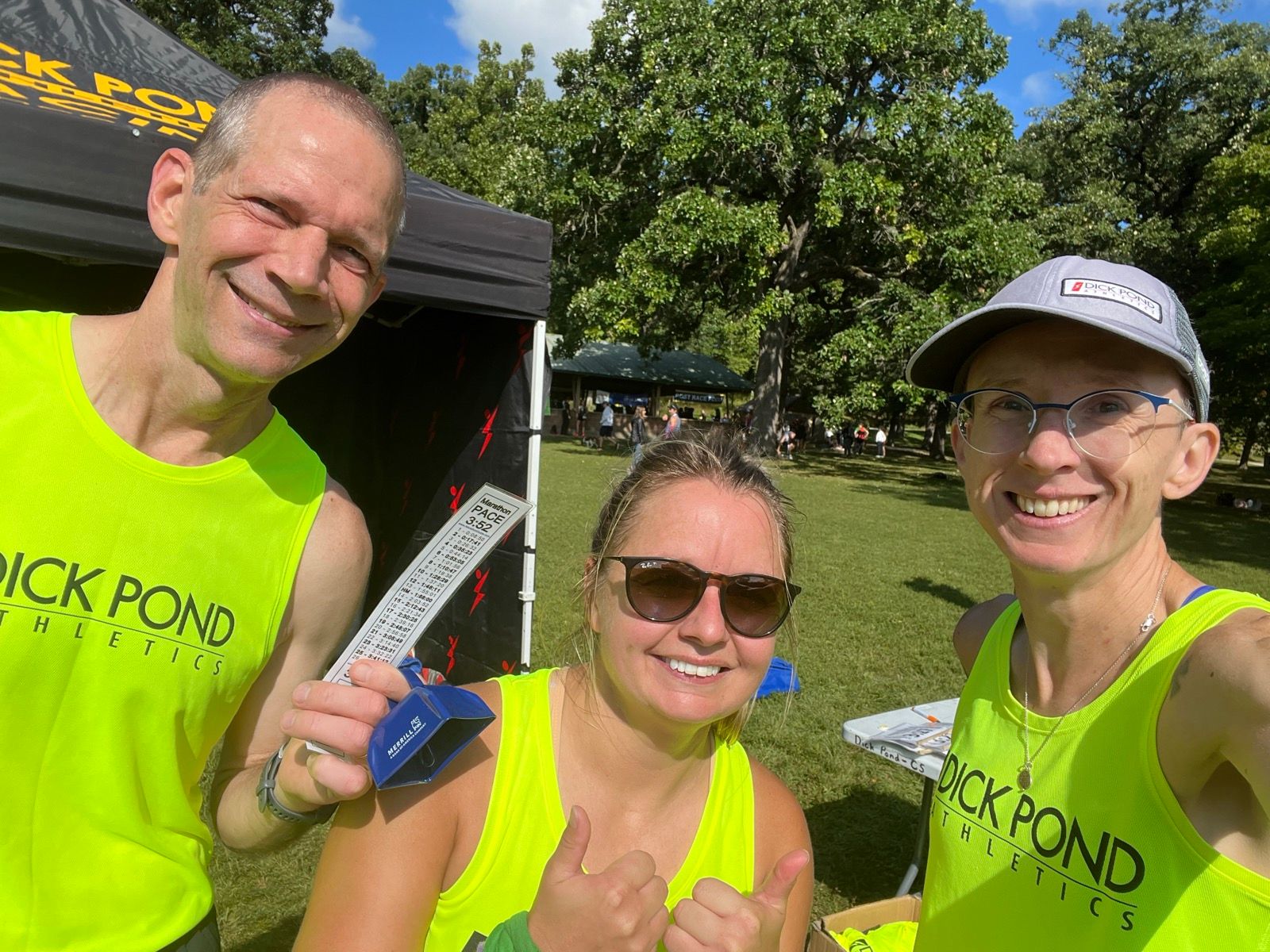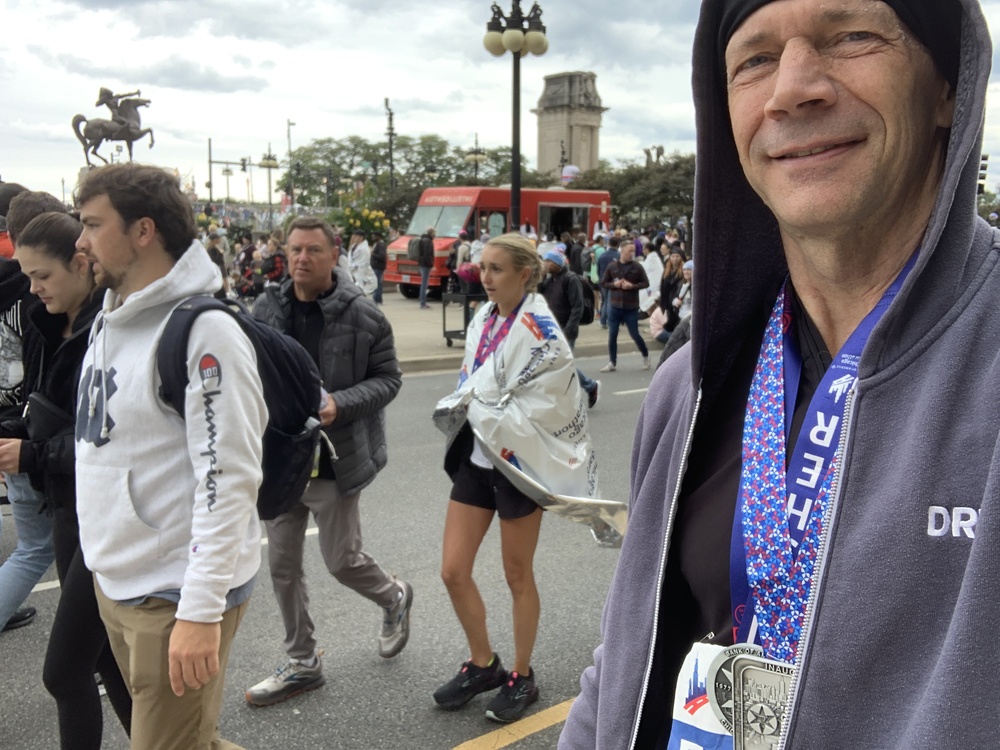Returning to the 2023 Chicago Marathon after 14 years
Sunday, 8th October - It hurt so much, and went so well!
I am the same age as my Dad was when we ran the Chicago Marathon together in 1999–his last and my first, as it turned out. He focused on half-marathons after that, and I tried to get better at marathons.
After that first marathon with Dad, I ran seventeen more. Ten years later, after Chicago 2009, I’d had enough. My times were slowing, training was getting harder to fit in, and injury became a struggle.
Starting the Journey
In October 2022, a lunchtime run along the Chicago lakefront took me near Buckingham Fountain. I saw the gear check pavilions being set up and realized that the 2022 Chicago marathon was happening that Sunday; nostalgia ensued.
Me and my friend Jorge in 2008
The Chicago Marathon now uses a lottery system. I entered but did not win. In that case, the way into the Marathon is to fundraise for a Marathon-partnering charity. I chose the Lisle Arboretum, as they had invited me to run as a charity fundraiser. The Arb has been an enduring local influence–a great place to run in the winter, cool exhibits in the midst of nature, and a wonderful place to walk, learn, and relax. Thomas Dambo's Trolls were recent Lisle Arboretum guests.
Joe the Guardian
Preparation
Since October 2018, I’ve been running 10 miles most Saturdays with Dick Pond Athletics. Twenty miles/week is comfortable–enough to make Saturdays fun, but not enough to start getting tired and injured.
Would I be able to sustain the kind of mileage a marathon effort would require? I wasn’t sure. In 2019 and early 2020, I tried pushing weekly mileage toward 30. I ran 1,500 miles in 2019–a lifetime high–but paid for it. Plantar fasciitis took me out for four months the next summer. I was concerned that a marathon training push might trigger a relapse.
January - Start of Training
What goal to shoot for? I felt that breaking four hours (a 9:09 pace) would be appropriate–conservative, but still a challenge given the injury concerns, and the unknowns associated with fourteen years away from marathoning.
In January and February, I nudged weekly mileage up from the low 20’s to the mid-20’s, but felt plantar fasciitis creeping back into my life. I massaged and stretched, and it slowly subsided again.
26 March, I ran the Shamrock Shuffle, averaging approximately 7:32/mile. Not my favorite event, but good practice for downtown race-day logistics.
April - 30 miles/week
April 1, I hit my first 30-mile week. It took longer than expected, but things were going pretty good. Plantar fasciitis was under control. I had a daily stretch and massage routine that was gradually working the knots and soreness out of my feet, ankles and calves.
Dick Pond’s speed workouts on the Benet Academy track started in early April.
June - long-run ramp-up
June 4th, I ran the BofA 13.1 at Garfield Park, in 1:46:25. Not a bad effort; the day was a little warm.
I ran this partly because I had discovered the “Distance Series” perk: Running the Shamrock Shuffle, BofA 13.1, and Chicago Marathon in the same year guarantees entry into next year’s Chicago Marathon. So just in case…
By mid-June, I had settled on a marathon training plan. My Dick Pond friends suggested a routine that focused on three key days:
- Speed - Tuesdays
- Tempo - Thursdays
- Distance - Saturdays
A variation of this approach is expanded in a “Less-is-More” Marathon training plan featured in Runner’s World in 2005. It has its skeptics, but my experience was that it allowed me to be less tired and increase long-run mileage without getting hurt. I didn’t follow it rigorously, but did put focused effort into the run days.
July - long-run ramp-up
8th July marked the beginning of longer mileage, starting with a 14-miler. I had done this distance and more earlier in the year, but for reasons unclear this run was really tough; I was wiped out toward the end, to the point that my Garmin watch noted “excessive fatigue”. Thanks Garmin.
Two weeks later, I did 15 miles in Loveland, Ohio, along the Little Miami Scenic River Trail (we were in the Cinci area for a family event). It went much better, 8:47 average and I felt decent at the end.
One week later on the 29th, I did 18 miles–a little slower at 9:00–but felt even better.
August and September - 20-milers
The schedule allowed room for multiple 20-milers leading up to the taper period.
The first one was 11 August, on the Tunnel Hill Trail . It had been decades since I had run all the way up to the tunnel and back.
The track workouts were happening most Tuesdays during from mid-April onward, and similarly for the Thursday tempo runs.
Sunday, 17 September - Last long run - 24 miles
The previous Saturday, I had paced the 8:50 group for the first half of BQ2 (by now, I was thinking 8:50 would be a decent goal marathon pace). After finishing the pacing gig, I did another 6-ish miles to make it 20, but barely finished it: At 19.9, I got a stitch in my side 🥴!
Now, due to shuffling the calendar around, I was “off-by-one” week: My final and longest run needed to be 3 weeks out, which fell only 8 days later. I couldn’t wait a week, because a 2-week taper is too short. I could taper starting from now, but a 4-week taper felt like too long.
Main goals:
- Practicing 4-plus hours of time-on-feet, and
- Not getting hurt.
Sunday was very wet all morning (as the Fox Valley marathoners could testify!) I waited until the rain stopped around 2:00 p.m., and did 24 miles, finishing in Batavia at sunset. It had turned into a beautiful afternoon to tour the countryside on foot!
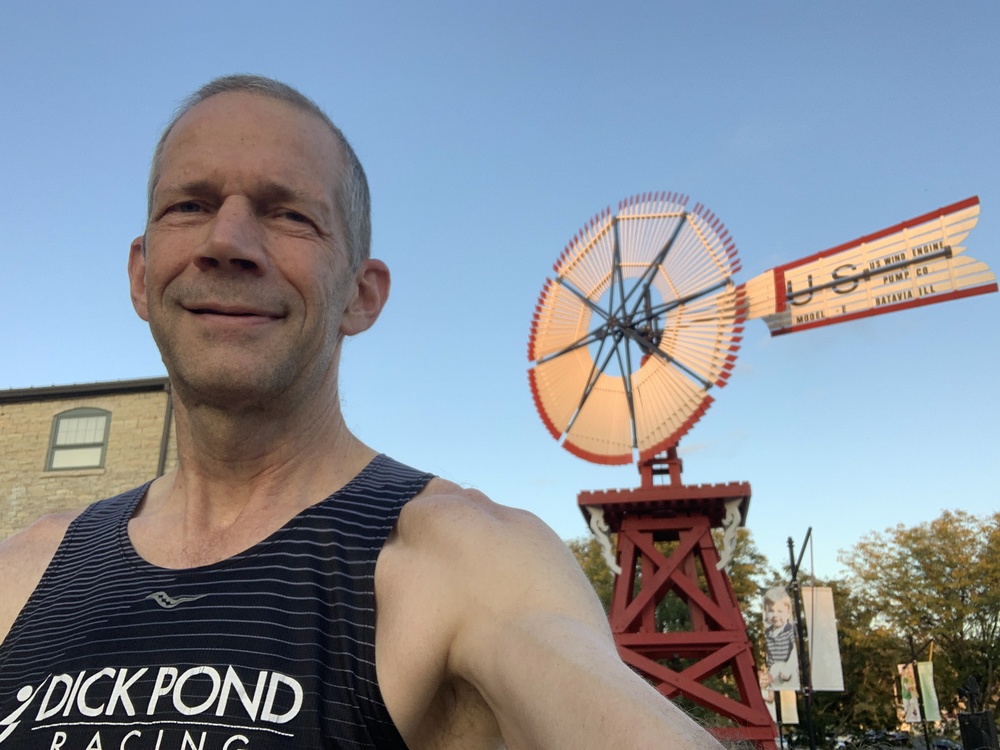
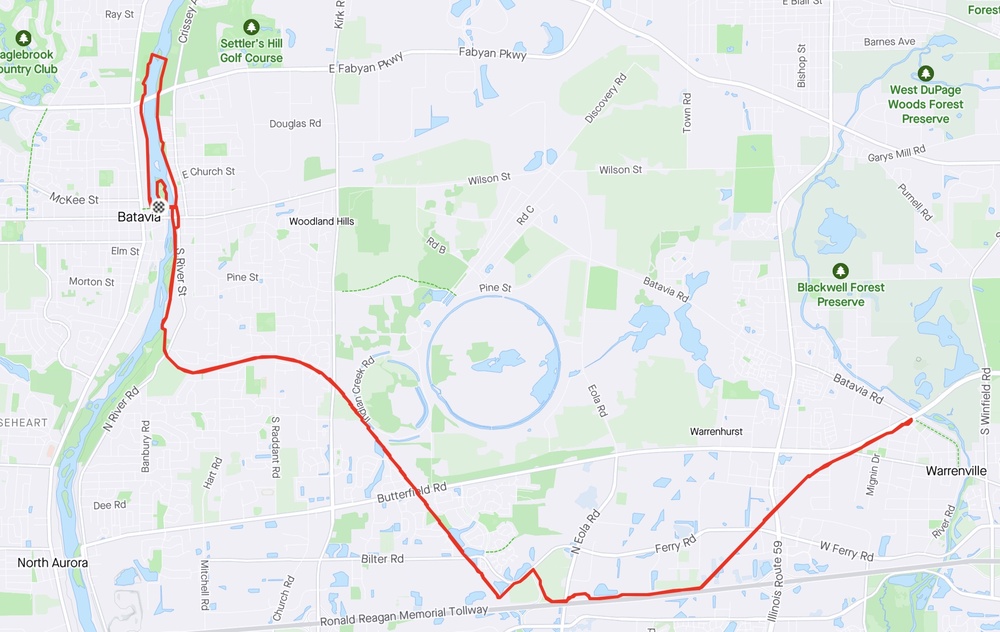
I considered it a successful run. However, I could only do a walk/run pace for the last two miles, and it took 4 hours 20 minutes. Would I be able to run two more miles, in half an hour less time?
Also, my right knee felt a little tender. I was pretty sure I’d managed not to hurt it, but would it also be a factor?
Taper
I didn’t run much. I cut out the Thursday tempo runs, went easy on the speed workouts, and did 10, and then 8 on the next two Saturdays. For some reason, my right quad felt significantly sore after the 26th Sep speed workout, a week and a half before the Marathon. To this day, I have no idea why. I massaged and stretched it daily. (My mini-Theragun was my best friend all along this journey!)
Race Strategy
During the 20-milers, I had practiced the nutrition I would follow on the course:
- A chewable salt tablet every 2 miles
- A gel every 4 or 5 miles
- Water with electrolytes every mile or more often - from a 14-oz handheld squirt bottle.
Race Day
The weather was 45F, calm and overcast, warming slightly to the low 50’s by noon–in other words, perfect. I don’t think I’ve ever experienced better weather for a marathon.
5:30 a.m. - Grant Park
I parked at the 210 South Wabash garage (Yay, SpotHero) and arrived at the security check for race village. No personal bags allowed for runners; just the clear gear check bags acquired at picket pickup.
The Hospitality Tent
I had signed up early and paid $170 extra for a ticket to the Hospitality Tent–pricey, but worth it! Post-race massage, lots of food, heated, private portapotties and gear check, and a visit by the men’s and women’s winners.
Pre-race routine
Given that Wave 2 would start at 8:00 a.m. …
- Get to the tent by 6:00 a.m.
- Stay off my feet as much as possible.
- Take a bathroom break as late as possible–about 7:00 a.m.
- Leave for my corral at 7:30–15 minutes before it closes at 7:45.
- Get up front as far as possible in my corral.
Start
Made it to Corral F, which was mostly full when I got there.
Goal pace: 3:51:36, which is 26.21875 * 8:50.
Mile 1
Corral F got off to a good start. I hoped the crowd would thin out.
Early in a run, my Garmin watch reports a metric it calls “performance condition”. If I’m well rested, it will be “+4” or higher. If I’m a little tired, “0” or “-1”. After three weeks of tapering, Garmin tagged me with “+1”. Not a great vote of confidence for the next 25.6 miles. Thanks Garmin.
At the 1 Mile mark, I punched the “stop” button instead of the “lap” button on my watch, meaning that from here on, my watch and my pace wristband were useless for telling me whether I was on goal pace. Doh!
Mile 2
Near mile 2, I found out I punched the wrong button. I restarted my watch; it had been stopped for 6:26, but there was no way to know that at the time.
Mile 3
I looked around for a pace group, and saw one up ahead. It was too far away to tell which group they were, but I picked it up a little and caught up with them over the next mile. It turned out to be the 3:50 pacers. A little faster than I was planning, but I decided to hang onto them for as long as I could.
Mile 8
About this point in the race–almost a third into it–I can begin to tell whether this is going to feel good, or meh, or not fun. My legs were feeling a little ragged, which translated to This is going to be really rough.
Dick Pond running buddy Orlando Lara found me at about this time. We were both in Corral F and were aiming for 3:50-ish, but had not connected before now.
Mile 13.1
“This is where the race starts”, they say. I was still with the 3:50 group, but the course was extremely crowded, and it was getting harder to stay with them.
Mile 15
The 3:50 pacers commented that we were about 45 seconds ahead of the 3:50 goal. My quads and calves were telling me We can’t keep this up. Eleven miles to go …
Mile 20
There were twenty-one aid stations arranged along the course. Every aid station visit was a chaotic pit stop: Merge from the middle to the side, grab a cup of water or Gatorade cup, merge back without spilling your liquid or crashing into other merging runners, drink while running, and rejoin your pace group, who somehow seemed not to slow down during this process 🤔. I was carrying a 14-oz squirt bottle, which meant I could skip a couple aid stations, IF I managed to snatch and transfer three cups in the same pit stop.
Catching up with the pacers after an aid station was becoming a really difficult test of will. I found myself wishing my calves would cramp, or I’d get a side stitch, so I would have to stop or at least slow down. But it didn’t happen. Great pain, but nothing mechanically wrong. Darn it.
Mile 23
I’ve invested too much into this pace to fall off now. Only 3-ish miles to go. I decided, I’ll keep it up until something happens.
Mile 25
The pacers urged me, Go on ahead! But I didn’t have anything left for that nonsense.
Mile 26
Right turn up the Roosevelt Road hill. What a terrible place for a hill. But only a few hundred meters left. I heard someone shout “Chris Walquist!”. I looked left, and there was Sam Testa in the front of the crowd. How did he see me? What was he doing there?
Finish!
Left onto Columbus Drive. I staggered onward to the finish line, picking up the pace as much as I could–that is, very very slightly. I punched the watch (again the wrong button, as a discovered later!) I had stayed with the pacers, which was incredible, but since I had not started with them I didn’t know exactly how I’d done; they might have started a few seconds earlier or later, which would mean our chip times differed.
Orlando was right there! What a great feeling. I quickly began to forget that only a few minutes earlier, I was thinking Never Again.
Post-Race
As soon as I stopped running, my legs stopped hurting. They did cramp slightly, but not much. Still, I dared not sit down. I made my way back to the Hospitality Tent and was quickly assigned a massage table hosted by Luis, he of the magic hands.
Eventually, I thought to look up my race results in the Chicago Marathon app:
3:49:04 - better than my 2009 Chicago Marathon time by 7 minutes and 38 seconds!
Summary
So many things went right, and the things that went “wrong” conspired to help me do better than I planned or expected. I had tried as hard as I possibly could, and it was just enough. If I had executed my original plan, I would have finished about two and a half minutes slower!
Past Updates
Thursday, 5th October - Marathon is three days away!
I picked up my Marathon packet at McCormick Place. My bib number is 27438!
I’m planning on carrying my phone. You can download the Chicago Marathon app if you want to track my progress live.
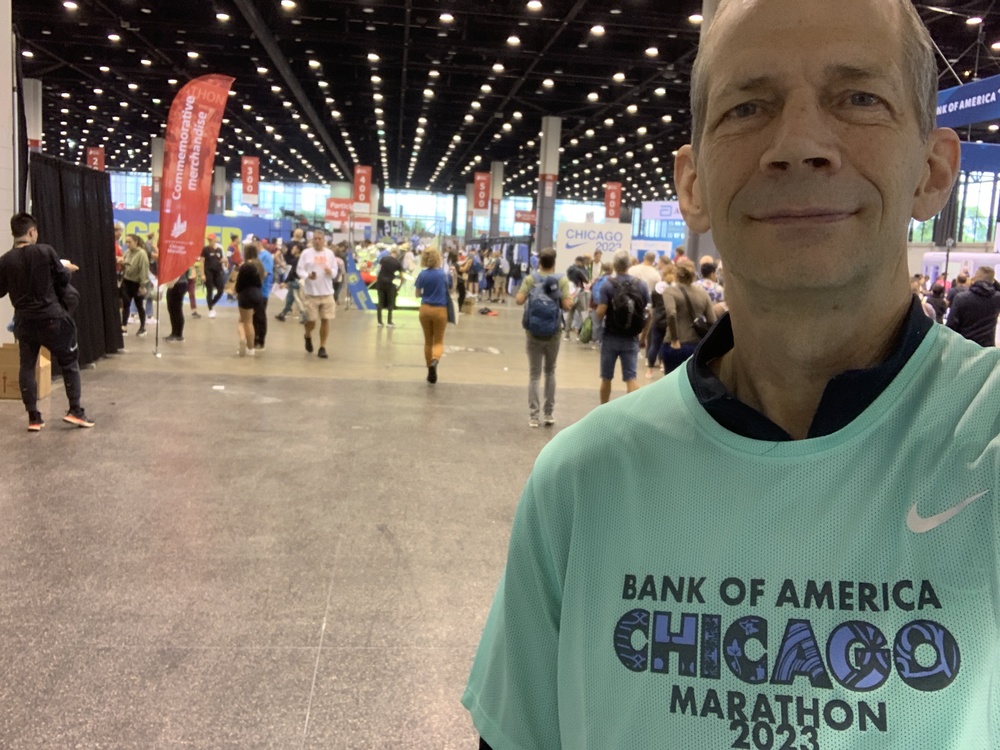
Go here for iPhone or here for Android, or search “Bank of America Chicago Marathon” in the Apple or Google Play stores.
The 2023 Chicago Marathon is Sunday, 8th October.
9 September 2023 - BQ.2 Pacing, and 3rd 20-miler
I helped pace the first half of the BQ.2, a race for folks hoping to qualify for Boston. My pace group was the same as my goal pace: 8:51 per mile, or about a 3:52 marathon.
It was great pacing with Abby and Krista; we dialed in the 1st-half splits right on the nose!
After the pace gig, I stayed on the course for another few miles to make it 20. Looking good for October 8th!
